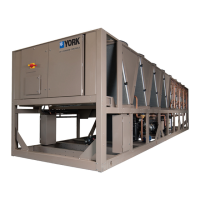JOHNSON CONTROLS
172
SECTION 9 - MAINTENANCE
Form 201.28-NM1.1
Issue date: 08/06/2021
Table 26 - Troubleshooting guide (cont'd)
Problem Possible cause Action
System fault:
High discharge pressure
Coils dirty. Check and clean coils.
Coils are damaged. Comb out ns.
Fans NOT operating.
Check fan fuses.
Check fan rotation.
Check fan motor/blade.
System is overcharged. Remove charge and check subcooling.
System fault:
High discharge temperature
Discharge Temperature Sensor is defective. Check Sensor.
Condenser Fans NOT operating or are run-
ning backwards.
Check Fans.
Coils dirty. Check and clean Coils.
High Superheat.
Measure Superheat with gauges and
thermocouple. Determine cause.
System fault:
High motor temperature
High Motor temperature input from one of the
sensors.
Refrigerant charge low. Check subcooling.
Excess charge in system, High discharge
pressure. Check subcooling.
High Superheat. Drain/Feed Valves NOT
controlling. Isolate cause.
Motor Sensor reading incorrectly. Program
panel to ignore a single sensor.
Economizer Solenoid energized at low
speeds. Valve is leaking through.
System fault:
Low suction pressure
Low charge. Check subcooling.
Transducer reads incorrectly. Check transducer against a gauge.
Suction Temp. Sensor reads incorrectly. Check sensor against a thermocouple.
Low ow. Check ow.
Condenser Drain (Flash Tank Feed) Valve
NOT operating.
Check Feed and Drain Valve operation.
Check superheat.
Condenser or Drain (Flash Tank Feed) Valve
defective.
Check Feed and Drain Valve operation.
Check superheat.
System fault:
Discharge pressure limiting
Discharge Transducer is defective. Check transducer against a gauge.
Ambient Temp. very high. Normal operation.
Fans not operating. Check fan operation.
Remote or local discharge pressure
load limiting is programmed.
Normal operation.
Note: Always remove power to the chiller and ensure the DC Bus voltage has bled o.

